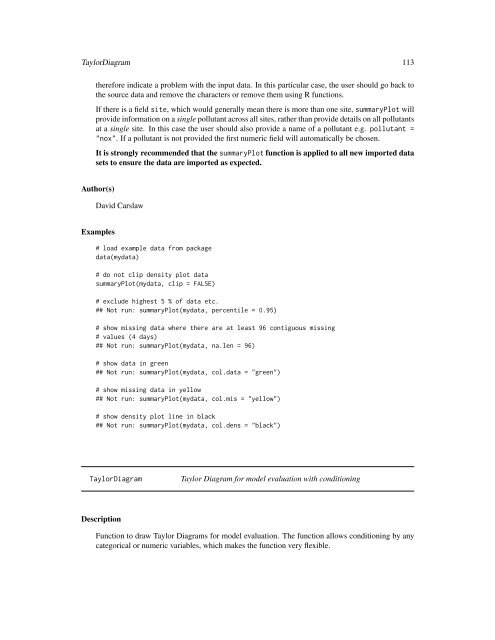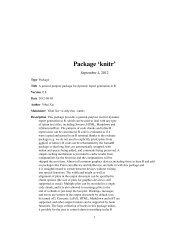Package 'openair'
Package 'openair'
Package 'openair'
Create successful ePaper yourself
Turn your PDF publications into a flip-book with our unique Google optimized e-Paper software.
TaylorDiagram 113therefore indicate a problem with the input data. In this particular case, the user should go back tothe source data and remove the characters or remove them using R functions.If there is a field site, which would generally mean there is more than one site, summaryPlot willprovide information on a single pollutant across all sites, rather than provide details on all pollutantsat a single site. In this case the user should also provide a name of a pollutant e.g. pollutant ="nox". If a pollutant is not provided the first numeric field will automatically be chosen.It is strongly recommended that the summaryPlot function is applied to all new imported datasets to ensure the data are imported as expected.Author(s)David CarslawExamples# load example data from packagedata(mydata)# do not clip density plot datasummaryPlot(mydata, clip = FALSE)# exclude highest 5 % of data etc.## Not run: summaryPlot(mydata, percentile = 0.95)# show missing data where there are at least 96 contiguous missing# values (4 days)## Not run: summaryPlot(mydata, na.len = 96)# show data in green## Not run: summaryPlot(mydata, col.data = "green")# show missing data in yellow## Not run: summaryPlot(mydata, col.mis = "yellow")# show density plot line in black## Not run: summaryPlot(mydata, col.dens = "black")TaylorDiagramTaylor Diagram for model evaluation with conditioningDescriptionFunction to draw Taylor Diagrams for model evaluation. The function allows conditioning by anycategorical or numeric variables, which makes the function very flexible.
















